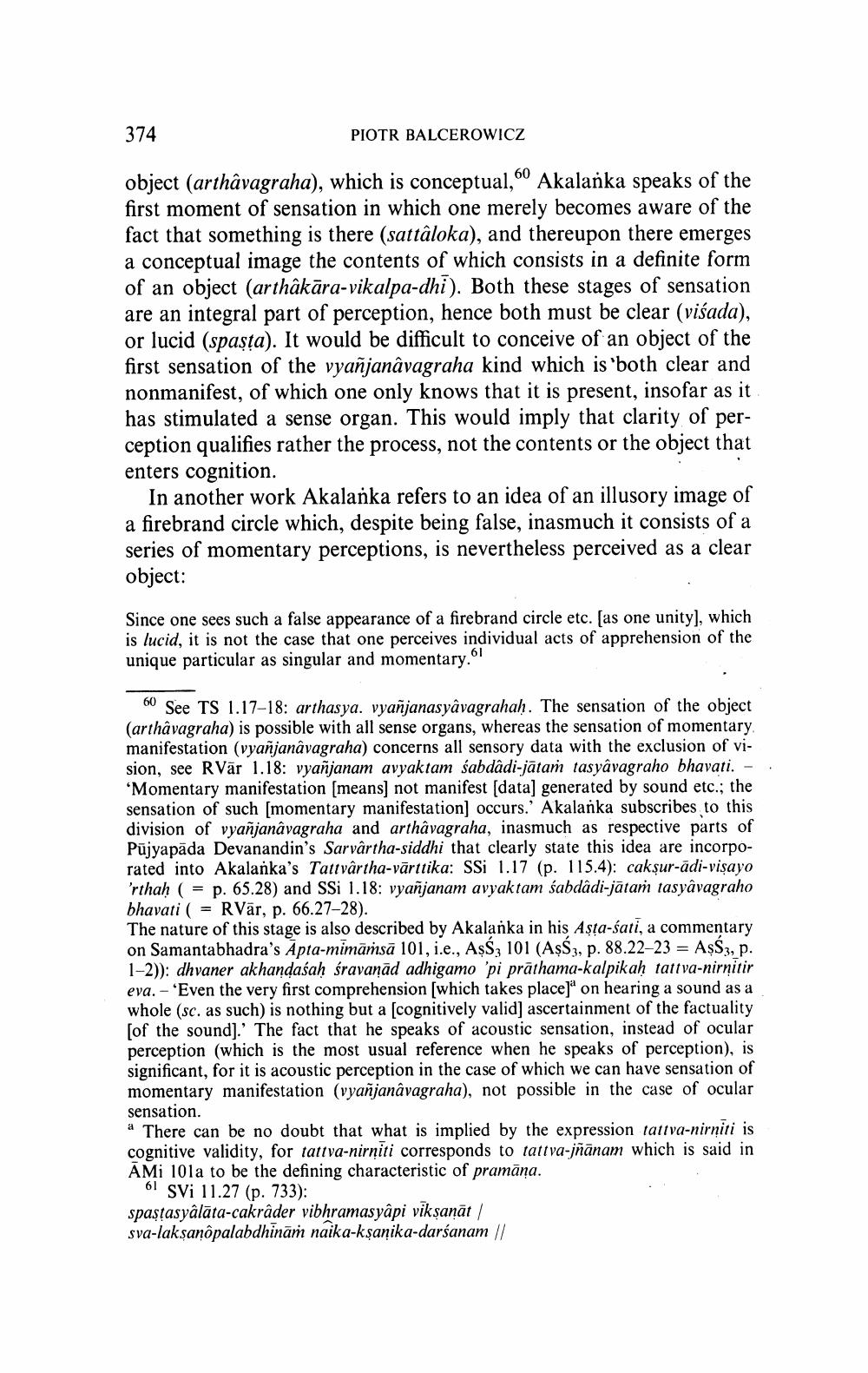________________
374
PIOTR BALCEROWICZ
object (arthâvagraha), which is conceptual," Akalanka speaks of the first moment of sensation in which one merely becomes aware of the fact that something is there (sattâloka), and thereupon there emerges a conceptual image the contents of which consists in a definite form of an object (arthâkāra-vikalpa-dhi). Both these stages of sensation are an integral part of perception, hence both must be clear (visada), or lucid (spasta). It would be difficult to conceive of an object of the first sensation of the vyañjanâvagraha kind which is both clear and nonmanifest, of which one only knows that it is present, insofar as it has stimulated a sense organ. This would imply that clarity of perception qualifies rather the process, not the contents or the object that enters cognition.
In another work Akalanka refers to an idea of an illusory image of a firebrand circle which, despite being false, inasmuch it consists of a series of momentary perceptions, is nevertheless perceived as a clear object:
Since one sees such a false appearance of a firebrand circle etc. (as one unity), which is lucid, it is not the case that one perceives individual acts of apprehension of the unique particular as singular and momentary
60 See TS 1.17-18: arthasya. vyañjanasyavagrahah. The sensation of the object (arthâvagraha) is possible with all sense organs, whereas the sensation of momentary, manifestation (vyañjanâvagraha) concerns all sensory data with the exclusion of vision, see RVär 1.18: vyañjanam avyaktam sabdâdi-jātaṁ tasyâvagraho bhavati. -. ‘Momentary manifestation (means) not manifest [data] generated by sound etc.; the sensation of such (momentary manifestation) occurs.' Akalanka subscribes to this division of vyañjanâvagraha and arthâvagraha, inasmuch as respective parts of Pūjyapada Devanandin's Sarvârtha-siddhi that clearly state this idea are incorporated into Akalanka's Tattvârtha-vārttika: SSi 1.17 (p. 115.4); cakşur-ādi-visayo 'rthah ( = p. 65.28) and SSi 1.18: vyanjanam avyak tam śabdâdi-jātam tasyâvagraho bhavati ( = RVār, p. 66.27-28). The nature of this stage is also described by Akalanka in his Asta-sati, a commentary on Samantabhadra's Apta-mimāṁsā 101, i.e., A$S3 101 (A$S3, p. 88.22–23 = A$S3, p. 1-2)): dhvaner akhandaśaḥ śravanād adhigamo 'pi prāthama-kalpikah tattva-nirņitir eva. - 'Even the very first comprehension (which takes place)" on hearing a sound as a whole (sc. as such) is nothing but a (cognitively valid) ascertainment of the factuality (of the sound).' The fact that he speaks of acoustic sensation, instead of ocular perception (which is the most usual reference when he speaks of perception), is significant, for it is acoustic perception in the case of which we can have sensation of momentary manifestation (vyañjanâvagraha), not possible in the case of ocular sensation. a There can be no doubt that what is implied by the expression tattva-nirniti is cognitive validity, for tattva-nirniti corresponds to tattva-jñānam which is said in AMi 101a to be the defining characteristic of pramāna.
01 Svi 11.27 (p. 733): spastasyâlāta-cakrâder vibhramasyâpi vikșanāt / sva-laksanôpalabdhinam naika-kşanika-darśanam //




